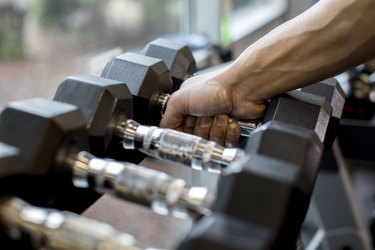
While a good workout can leave you tired and shaky, weakness in the hands after a workout could be normal, or a sign of something more serious. You may just need to make a minor adjustment in your sport.
Or you could be experiencing edema, carpal tunnel syndrome or peripheral neuropathy — or it may be an injury.
Video of the Day
Video of the Day
Determining whether or not your hand weakness after a workout is common or not can sometimes depend on what type of exercise you've been doing. A regular complaint from cyclists is that their wrists and hands feel weakness, clumsiness, cramping and pins and needles after a long ride. This is known as cyclist's or handlebar palsy, according to Adventure Cycling.
Usually, height adjustments to the bike can be made in order to relieve the symptoms and prevent similar pain on future rides. Further adjustments that can be made include making sure handlebar tape/grips have adequate cushioning, using gloves with adequate cushioning, and regularly changing hand position on bars.
Hand weakness is also a common problem among golfers, weightlifters and tennis players — and while symptoms are often attributed to overuse, it can signal a more serious problem. If you are experiencing weakness in your hands, make an appointment with a sports medicine specialist.
Edema and Hand Weakness
Weakness in the hands after a workout could also be a symptom of edema. Exercise increases blood flow to your heart and lungs and to the muscles you're working. This can reduce blood flow, making your hands cooler.
In turn, the blood vessels in your hands may overreact by opening wider, which could lead to swelling, according to the Mayo Clinic. While edema is common, it could be caused by underlying medical conditions, certain medications or pregnancy, so you should see a doctor if you are regularly experiencing symptoms during exercise.
Read more: What Is Edema and How Can Walking Trigger It?
Carpal Tunnel Syndrome
Carpal tunnel syndrome is a painful progressive condition caused by compression of a key nerve in the wrist, signified by pain, weakness, or numbness in the hand and wrist radiating up the arm. This syndrome could be caused by repetitively holding your hands on exercise equipment the same way.
Early diagnosis and treatment is important to avoid permanent damage to the median nerve, according to the National Institute of Neurological Disorders and Stroke, so it's important to see your doctor right away if you suspect you have carpal tunnel syndrome.
Peripheral Neuropathy and Other Causes
In some cases, weakness in the hands may be a sign of peripheral neuropathy, which means that a nerve or group of nerves has been damaged. The most common cause of peripheral neuropathy is diabetes according to Medline Plus, but other diseases that can cause neuropathy are rheumatoid arthritis, lupus and chronic kidney disease.
Treating the cause of nerve damage, if it is not inherited and if it is known, may improve your symptoms, according to the National Institutes of Health. Additionally, weakness in the hands may be a sign of a direct nerve injury such as a crush or cut.
Some patients with pain will often describe numbness and tingling generally at the site of the problem and this probably represents a general response to pain/swelling rather than a specific nerve injury. If you have injured your hand, you should see a doctor immediately who may recommend hand strengthening exercises or other treatment.
- Mayo Clinic: "Edema"
- National Institute of Neurological Disorders and Stroke: "Carpal Tunnel Syndrome Fact Sheet"
- Medline Plus: "Peripheral Neuropathy"
- Adventure Cycling: "Don't Put Up with Wrist Pain"
- American Council on Exercise: "Muscle Imbalance | 6 Things to Know About Muscle Imbalances"
- National Institutes of Health: "Peripheral Neuropathy Information Page"